- Know about the incredible story of the Kailashanatha Temple, its
architecture and how it inspired Raja Raja Chola to make the Brihadesvara
Temple at Tanjore.
Welcome to Kanchipuram, the land of ancient temples and timeless
spirituality! Located 75 kms away from Chennai in Tamil Nadu, Kanchipuram is a
city steeped in history, culture, and architectural marvels that date back
centuries. Renowned as one of the seven Moksha-puris, or cities that grants moksha,
Kanchipuram holds immense significance in Hindu religious tradition.
Whether you're a devout pilgrim seeking spiritual enlightenment or a curious traveler eager to uncover the secrets of India's past, Kanchipuram welcomes you with open arms.
Rajasimha, also known as Narasimhavarma-II, the builder extraordinaire, created this beauty which is a real treasure trove for anyone into art and history. But even if you're not a history buff, you will still be blown away.
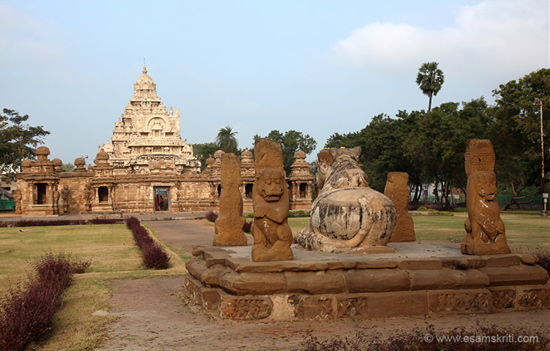
This is one of the most ornate and early-built structural
temples in Kanchipuram. Kailasanatha temple is located west of Kacchapehsvara
temple and south of Ekamreshvara temple in the Shiva Kanchi part of the city.
The temple is a protected monument under ASI and has a picturesque setting
amidst lawn, tank etc.
The temple is a treasure for every art and history enthusiast and is significant even for the devout worshipper. Built around 700 CE, this temple is a total showstopper. It's like a four-story sandstone masterpiece, facing east with a rectangular layout
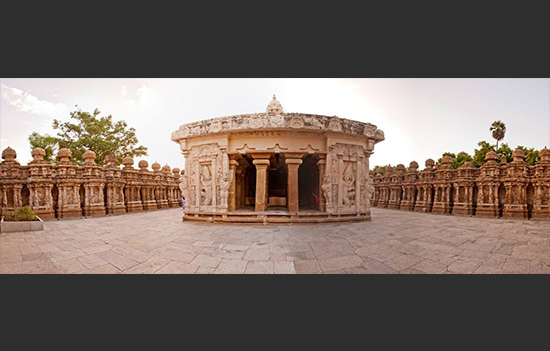 Kailashanatha- Panaromic view.
Kailashanatha- Panaromic view.
Rajasimha was a prolific builder, and we get to know about his religious leanings from several of the Birudas, epithets, that are inscribed within the precinct of this temple, namely - the follower of Agamas (Agamanusari), a lover of Epics (Ithihasapriya), and a follower of Shaivaite path (Shaiva-siddhata-marg). It is therefore not surprising that his best efforts were put into designing and constructing this temple in Kanchi, the city considered by Lord Shiva himself to be his eye along with Kashi.
The temple is a typical example of a royal shrine, built in sandstone. At the entrance, before entering the Kailasanatha temple, we come across the Mahendravarma Simhesvaram, a temple constructed by the son of Rajasimha, Mahendravarman-III. Temple built in 700
CE, the Kailasanatha temple, also known as Rajasimheshvaram after
Rajasimha, was laid out as per the dictates of the Vastu Sastra.
The temple
consists of numerous representations of Shiva in its various manifestations as
sandstone sculptures.
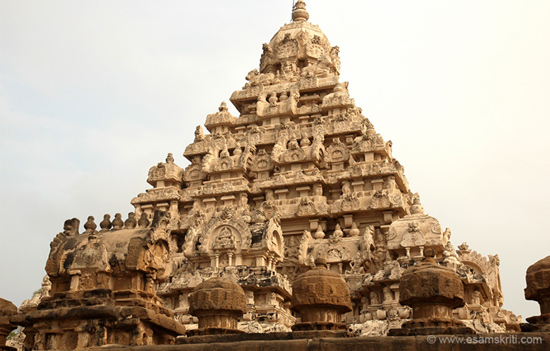
The temple faces east and follows a rectangular plan. The temple
has four stories and has a square structure up to the griva. The sikara above
is octagonal. The temple is adorned with nine abutting sub-shrines, of which
seven are seen from outside on the south, west and northern sides of the main
Vimana, and two are located on either side of the central shrine on the east
inside the ardhamandapa. These
sub-shrines have various representations of Lord Shiva, carved in a uniquely
Pallava style.
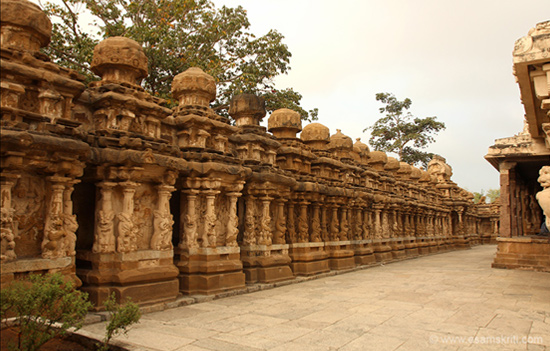
The Sandhyatandava
depiction has four-armed Shiva dancing along with pramatha ganas, his
attendants positioned below, with Brahma and Vishnu watching from either side.
 Sandhyatandava
Sandhyatandava
There are many such beautiful depictions within. The north and
south walls are plain, without much ornamental decoration. The entrance to the
garbhagrha is away on the south with a four-pillared veranda in front.
The Garbhagrha houses the Kailashanatha
linga, a large, polished Dharalinga with sixteen facets. One can see on the
rear wall a particular niche with the Somaskanda panel, with Siva and Uma seated
with the baby Skanda and Brahma and Vishnu standing behind the couple.
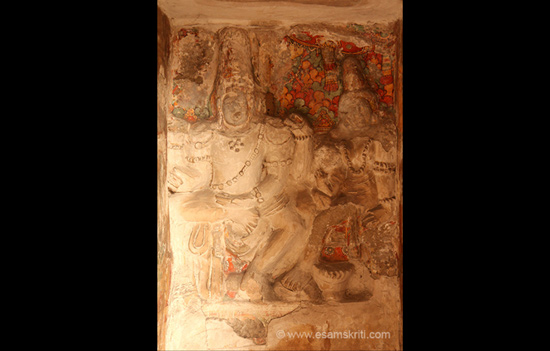 Somaskanda from the outer panel.
Somaskanda from the outer panel.
The garbhagrha is guarded by the two Dvarapalakas. There is a circumambulatory passage around the garbhagrha which is very narrow and can be crossed if one crawls through it. It is made possible by the two walls of the double-walled system around the sanctum-sanctorum. This circumambulatory passage is called garbhavasa,
and the sthalamahatmya speaks of this pradakshina, and it ensures that there
would be no rebirth for the devotee who performs it.
The artistic design and the unique layout of the temple are
considered to be the forerunner of the artistic developments that followed in
Temple design and construction.
Raja
Raja Chola was greatly influenced by this temple design during his stay
at Kanchi. Arulmozhivarman who came to be later known as the Raja Raja Chola I,
was the crown prince while his uncle Uttama Chola ruled from Tanjavur. During
his stay in Kanchi he invited silk weavers from
Saurashtra, Gujarat, to relocate to Kanchi, thus starting the long Silk
weaving tradition of Kanchipuram.
Before his time, the largest temple of his land was the Kailasanatha temple, Kanchipuram. He calls it as ‘kachipettu periya kattrali’ i.e. the big temple of Kanchipuram, in his inscriptions. Upon assuming the crown, he tried to emulate the tall Vimana design, which belongs to ‘Kailasa prastara’ style according to shilpa texts on a grander scale. The Brihadishvara temple that he executed was 40 times in size of the Kailasanatha structure.
The engineering skills of the artists are remarkable in the
construction design of the superstructural talas, built over a bridge of slabs
spanning the top of the two massive walls. There are a series of Vrshas (Bulls)
in the inner courtyard, which are placed on the ground, and face the different
quarters.
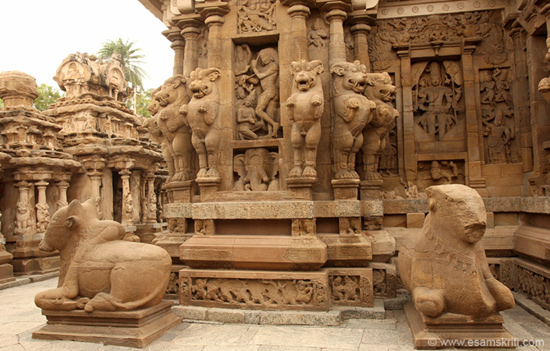 Vrshas from inner prakaras.
Vrshas from inner prakaras.
The outer walls and the devakoshtas contain some remarkable and
beautiful sculptures. As if not wishing to waste even an inch of available
space, every part of the temple has some appropriate detail. These panels are
striking in arrangement and very artistically executed, with even the smallest
ornament being clearly and beautifully cut.
Some of the forms that stand out are the Gajalakshmi with
dvarapalakas on either side, Ekadasa
Rudras- the eleven manifestations of Shiva, namely - Sadyojata, Vamadeva,
Aghora, Tatpurusha, Ishana, Mrtyunjaya, Vijaya, Kiranaksha, Aghorastra,
Srikantha and Mahadeva. Also, the Dvadasha Adityas, Mahishamardini,
Dakshinamurti, Bhikshatana, Andhakasura samhara, etc.
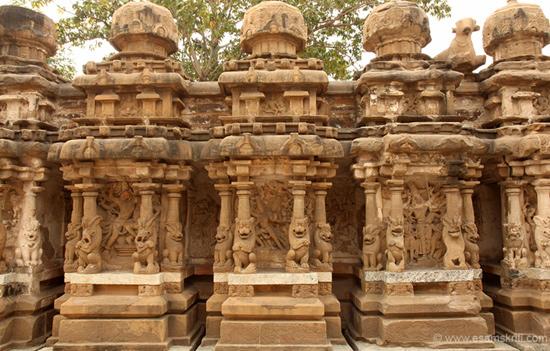
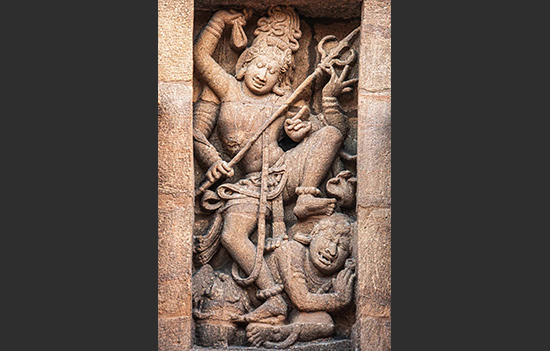 Kalasamhara – Destroyer of Yama.
Kalasamhara – Destroyer of Yama.
 Gangadhara.
Gangadhara.
In the inner face of the inner prakara there are 55 parivara shrines of Shiva facing east with
small dvitala vimanas (except two dedicated to Brahma and Vishnu, which have a
square and a kuta type vimana). Many of these shrines have traces of fresco paintings on the main walls. These shrines
stand over a charming moulded and raised adhishthana and are supported by thick
granite stone slabs at the bottom of the structure. The granite slab at the
bottom was introduced to keep the structure stable and prevent water
penetration into the core of the sandstone structure above.
Though introduced for engineering reasons, the artists used
these granites to engrave in the calligraphic Pallava grantha characters enumeration of the various titles of
Rajasimha Pallava. There are about two hundred and fifty titles which are
inscribed around the temple built by him.
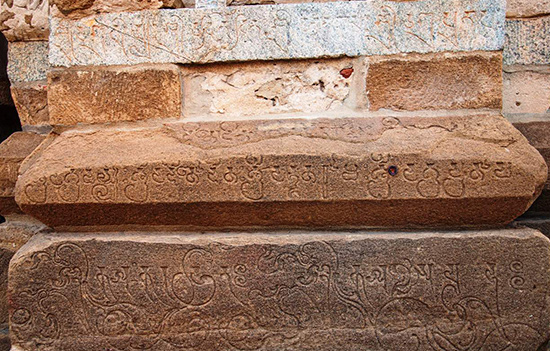 Rajasimha’s titles inscribed in three different styles.
Rajasimha’s titles inscribed in three different styles.
In front of the temple complex stands a row of eight small
shrines with kuta vimana, amongst which only five have Shivalingas intact. They
all contain the Somaskanda panels on their rear walls and varied sculptures on
their external walls.
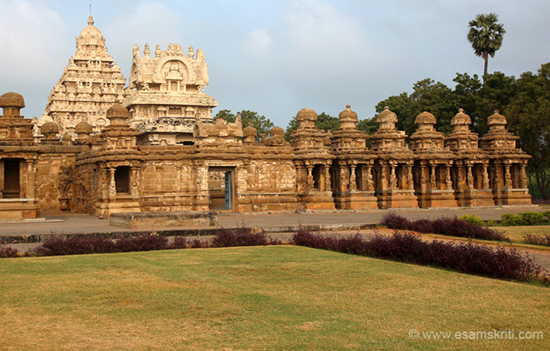
The sculptural beauty of this temple was so marvelous that when Chalukya Vikramaditya I invaded Kanchipuram, he left the temple undisturbed and his inscription on one of the pillars of the mandapa in front of the main sanctum of the sample records his grant of golden jewellery for the deity.
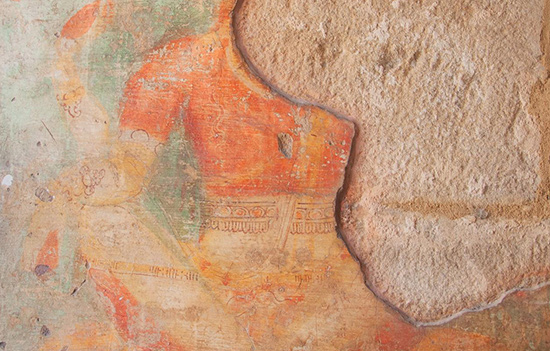 Surviving Painting in Kailashanatha- The whole temple was covered with such painting when Vikramaditya Chalukya visited it.
Surviving Painting in Kailashanatha- The whole temple was covered with such painting when Vikramaditya Chalukya visited it.
The legend about the kumbhabhisheka of the Temple:
Poosalaar Nayanar, one of the 63 Shaivite saints, was a
contemporary of Rajasimha and a staunch devotee of Shiva. He lived in
Thirunindravur, a suburb of Chennai. He was urged to build a temple for Lord
Siva and execute the same. He approached the wealthy and the powerful for help,
but to no purpose. He was saddened that a temple could not be raised as
planned. However, he was reminded that Lord Shiva dwells in the hearts of
sincere devotees. Thus he conceived the idea of building a temple within his
mind without the necessity of any external resources. He visualized in his mind
all the structural and engineering phases of the construction, one after the
other, the design, sculptures and their positions, the grand mandapas, a tall
vimana and all the requisite elements connected with the temple. His mental
temple was ready, and Poosalar fixed a date for conducting the kumbhabhisheka.
He fervently prayed to Lord Shiva to grace the occasion and occupy the seat
within the temple on the stipulated day.
It was the day that Rajasimha had fixed for the kumbhabhisheka of Kailashanatha temple grandly, and all the arrangements were in progress. Lord appeared in the dreams of the King and commanded him to postpone the date as He would like to grace the kumbhabhisheka of Poosalar‘s temple scheduled on that date. The King was surprised and wished to know more about the Poosalar’s temple at Thiruninravur.
When he reached there in person, there was no temple or sign of festivity. The King dispatched his soldiers and finally saw him seated under a tree, deep in contemplation, with his body puffed up with delight and showing signs of ecstasy. When he recovered from his meditation, the King told him about his dream and appreciated his sentiments. He offered to construct a temple in Tiruninravoor. Kailasanatha temple’s kumbhabhisheka was celebrated in the presence of Poosalar on a later date.
By this, the Lord showed the greatness of devotion and his devotees - Poosalar and Rajasimha. So, Lord Shiva was so touched by his devotion that he postponed the kumbhabhisheka of Kailasanatha Temple just to attend Poosalaar's Maanasika temple's Kumbhabhisheka. Talk about VIP treatment!
Rajasimha’s inscription in the temple throws a hint to mark this incident.
So, there you have it – the incredible story of Kailasanatha Temple. Here history, spirituality, and art come together in the most mind-blowing way possible. If you ever find yourself in Kanchipuram, do yourself a favor and pay this temple a visit.
Album Kailasanatha Temple
Album
Brihadesvara Temple, Tanjore
Album
Varadaraja Perumal Temple, Kanchipuram
To read all
articles by author Unless
watermarked pictures by
Author Dr Ketu Ramachandrasekhar is co-founder of Bharat ke Wow and course developer at Siddhanta Knowledge Foundation. He is also an expert panel member in Sangeet Natak Akademi. He has his Doctorate in Indian Epistemology and was selected as a Fellow from hundred young scholars across India for Studies in Neuro Aesthetics and Indian Rhetoric by Ministry of Culture, GOI. He was a part of Academic Team of scholars across Europe on discussion of Natya Texts. His expertise in Tantrashastra and Shaiva Pratyabhijna School is well recognised. He has several research articles and books to his credit which includes a detailed study of Abhinayadarpana of Nandikeshvara, Devi Mahatmya and others.